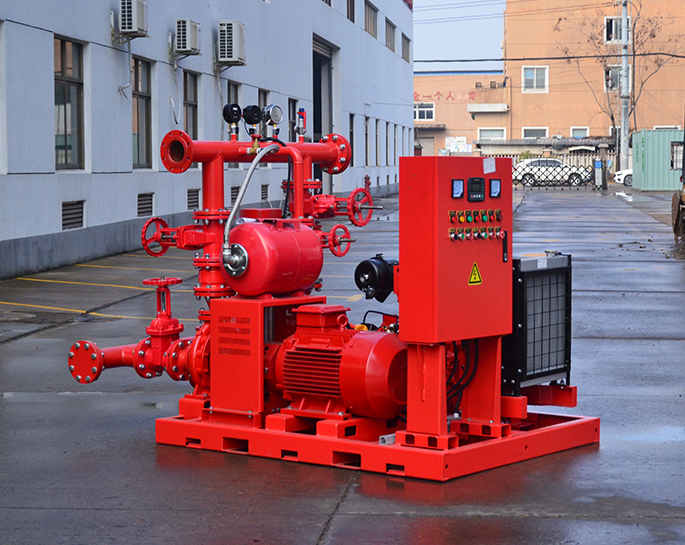How are fire pumps protected against freezing in cold climates, and are there heating solutions?
Feb 04, 2024
Share:
Fire pumps are critical components of fire protection systems, and protecting them against freezing is essential, especially in cold climates where sub-zero temperatures are common. Freezing conditions can potentially damage the pump and its components, compromising the reliability of the entire fire protection system. Here are common methods used to protect fire pumps against freezing, along with heating solutions:
1. **Enclosed Pump Rooms:**
- Placing fire pumps in enclosed pump rooms helps protect them from harsh external weather conditions, including freezing temperatures. The pump room should be properly insulated to minimize heat loss and maintain a temperature above freezing.
2. **Space Heating Systems:**
- Installing space heating systems within the pump room is a common practice. Electric or hydronic heating systems can be used to maintain a suitable temperature, preventing the water within the pump and associated components from freezing.
3. **Heat Tracing:**
- Heat tracing involves the use of electric or steam heat tapes along the pipes, valves, and other critical components of the fire pump system. This method ensures that these components remain above freezing temperatures, preventing ice formation.
4. **Thermostatic Heat Control:**
- Thermostatic control devices can be installed to automatically activate heating systems when the temperature drops below a certain threshold. These devices help maintain a consistent temperature within the pump room or around critical components.
5. **Insulation:**
- Proper insulation of pipes, valves, and other exposed components helps minimize heat loss and prevents freezing. Insulation materials such as foam or fiberglass are commonly used to wrap pipes and maintain a warmer temperature.
6. **In-Line Electric Heaters:**
- In-line electric heaters can be integrated into the fire pump system to heat the water as it flows through the pump and associated piping. This method ensures that the water remains at a temperature above freezing.
7. **Antifreeze Solutions:**
- Some fire protection systems use antifreeze solutions in the water supply to lower the freezing point. However, the use of antifreeze should comply with local codes and regulations, as certain types may have environmental or safety considerations.
8. **Climate-Controlled Pump Houses:**
- In addition to enclosed pump rooms, some installations utilize climate-controlled pump houses equipped with heating, ventilation, and air conditioning (HVAC) systems. These systems maintain a suitable temperature regardless of external weather conditions.
It's crucial to consult with fire protection engineers and adhere to local codes and regulations when implementing freezing protection measures for fire pumps. The chosen method should be tailored to the specific climate conditions and requirements of the installation to ensure the reliability of the fire protection system.

1. **Enclosed Pump Rooms:**
- Placing fire pumps in enclosed pump rooms helps protect them from harsh external weather conditions, including freezing temperatures. The pump room should be properly insulated to minimize heat loss and maintain a temperature above freezing.
2. **Space Heating Systems:**
- Installing space heating systems within the pump room is a common practice. Electric or hydronic heating systems can be used to maintain a suitable temperature, preventing the water within the pump and associated components from freezing.
3. **Heat Tracing:**
- Heat tracing involves the use of electric or steam heat tapes along the pipes, valves, and other critical components of the fire pump system. This method ensures that these components remain above freezing temperatures, preventing ice formation.
4. **Thermostatic Heat Control:**
- Thermostatic control devices can be installed to automatically activate heating systems when the temperature drops below a certain threshold. These devices help maintain a consistent temperature within the pump room or around critical components.
5. **Insulation:**
- Proper insulation of pipes, valves, and other exposed components helps minimize heat loss and prevents freezing. Insulation materials such as foam or fiberglass are commonly used to wrap pipes and maintain a warmer temperature.
6. **In-Line Electric Heaters:**
- In-line electric heaters can be integrated into the fire pump system to heat the water as it flows through the pump and associated piping. This method ensures that the water remains at a temperature above freezing.
7. **Antifreeze Solutions:**
- Some fire protection systems use antifreeze solutions in the water supply to lower the freezing point. However, the use of antifreeze should comply with local codes and regulations, as certain types may have environmental or safety considerations.
8. **Climate-Controlled Pump Houses:**
- In addition to enclosed pump rooms, some installations utilize climate-controlled pump houses equipped with heating, ventilation, and air conditioning (HVAC) systems. These systems maintain a suitable temperature regardless of external weather conditions.
It's crucial to consult with fire protection engineers and adhere to local codes and regulations when implementing freezing protection measures for fire pumps. The chosen method should be tailored to the specific climate conditions and requirements of the installation to ensure the reliability of the fire protection system.


.png)
.png)

.png)


